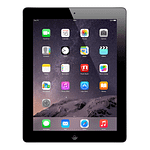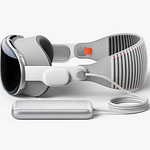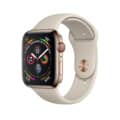- All Apple Devices
- iPad
- Apple iPad 3rd Generation Wi-Fi
Apple iPad 3rd Generation Wi-Fi
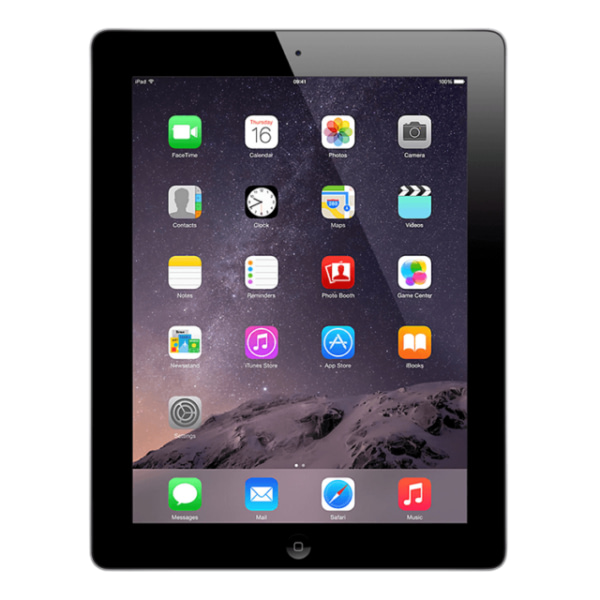
Apple iPad 3rd Generation WiFi
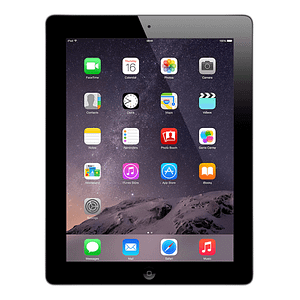
Product Brand: Apple
4
Pros
- Retina display
- Improved camera
- A5X chip
- Decent battery life
- Good app support
- iOS software
- Good sound quality
- Sleek design
Cons
- No water resistance
- Limited storage options
- Outdated hardware
- No stereo speakers
- No Touch ID
- Heavier than newer models
Apple iPad 3rd Generation WiFi Generation Specs and Features
The Apple iPad 3rd Generation WiFi, also known as the iPad 3, was released in March 2012. It features a 9.7-inch Retina display with a resolution of 2048 x 1536 pixels, providing crisp and clear visuals.
The tablet is powered by a dual-core Apple A5X processor and has 1GB of RAM. It comes in three storage options: 16GB, 32GB, and 64GB. It also features a 5-megapixel rear-facing camera capable of recording 1080p HD video, as well as a front-facing FaceTime camera for video calls.
Other key features of the iPad 3 include:
- WiFi connectivity
- Bluetooth 4.0
- Support for Apple’s Siri voice assistant
- 10 hours of battery life
- iOS 5 operating system (upgradable to iOS 9.3.6)
Compared to its predecessor, the iPad 2, the iPad 3 features a faster processor, a better display, and improved camera capabilities.
Although it has been several years since its release, the iPad 3 can still be a great option for those looking for a reliable and affordable tablet for browsing the web, checking email, and light productivity tasks.
Overall, the Apple iPad 3rd Generation WiFi offers solid performance, a high-quality display, and a range of useful features that make it a great choice for anyone looking for an iPad at an affordable price point.
Here’s a summary of the technical specifications for the Apple iPad 3rd Generation WiFi tablet:
- Processor/CPU: 1 GHz dual-core ARM Cortex-A9 Apple A5X
- RAM: 1 GB
- Internal Storage: 16 GB, 32 GB, 64 GB
- Display/Resolution: 9.7″ 1536×2048 pixels
- GPU/Graphics: PowerVR SGX543MP4
- Camera: 5MP
- Battery: 11560 mAh Li-Po
- Colours: Black, White
Full Technical Specifications
General
| Device Type | Tablet Computer |
| Models |
3th Generation iPad Wi-Fi Early 2012 MC706LL/A MC706LLA A1416 A1416, iPad3,1 |
| Announced | 07 March, 2012 |
| Released | 16 March, 2012 |
| Status | Discontinued |
| Predecessor | iPad 2 |
| Successor | iPad (4th generation) |
| Generation | 3rd |
Design
| Type Design Type called form factor refers to a mobile phone's size, shape, and style as well as the layout and position of major components of phone. There are three major form factors seen in mobile phones => bar phones, folding phones and sliding phones. | Bar |
| Width |
241.2 mm (millimeters) 24.12 cm (centimeters) 0.791 ft (feet) 9.496 in (inches) |
| Height |
185.7 mm (millimeters) 18.57 cm (centimeters) 0.609 ft (feet) 7.311 in (inches) |
| Thickness |
9.4 mm (millimeters) 0.94 cm (centimeters) 0.031 ft (feet) 0.37 in (inches) |
| Volume |
421.03 cm³ (cubic centimeters) 25.57 in³ (cubic inches) |
| Weight |
652 g (grams) 1.44 lbs (pounds) 23 oz (ounces) |
| Protection |
Scratch-resistant glass Oleophobic coating |
| Colors |
Black White |
Network
| SIM SIM (Subscriber Identity Module) is a small card that contains mobile network subscriber's account information. This allows the phone using the card to attach to a mobile network. The SIM card is most commonly associated with GSM and UMTS mobile networks. Moving a SIM card from one phone to another allows a subscriber to switch mobile phones without having to contact their mobile network carrier. SIM cards can also be used by a phone to store limited amounts of data, such as phone numbers and text messages. | No SIM |
Display
| Display Type Display Technology => A number of display technologies and types used in mobile phones => TFT (Thin Film Transistor), IPS (In-Place Switching), OLED (Organic Light Emitting Diode), AMOLED (Active-Matrix Organic Light-Emitting Diode), Super AMOLED (an even advanced version of AMOLED), Resistive Touchscreen (Resistive touchscreens contain two layer of conductive material with a very small gap between them which acts as a resistance), Capacitive Touchsceen (Capacitive touchscreen technology consists of a layer of glass coated with a transparent conductor) | LED-backlit glossy widescreen Multi-Touch display with IPS technology |
| Size | 9.7 inch |
| Resolution | 1536 x 2048 pixels |
| Display Colors Display Colors is refers to the number of different shades of colors that the screen is capable of displaying => 64K colors, 256K colors and 16 million colors, Obviously 16M is highest available range of colors and better than others. | 24 bit, 16777216 colors |
| Aspect Ratio | 4:3 ratio |
| Display area | (~65.1% screen-to-body ratio) |
| Pixel Density Pixel Density (PPI) is refers to the concentration of pixels on a particular display, measured in pixels per inch (ppi). Pixel density is calculated by dividing the diagonal pixel resolution of a display by its diagonal size, higher pixel density better display quality. | 264 PPI density |
| Display Protection Display Protection => Gorilla Glass is a special alkali-aluminosilicate glass shield with exceptional damage resistance that helps protect mobile displays from scratches, drops, and bumps of everyday use, It is always better to go for a smartphone with Gorilla Glass for that added protection and peace of mind. |
Scratch-resistant glass Oleophobic (lipophobic) coating |
| Features |
Capacitive Multi-touch Scratch resistant LED-backlit Oleophobic (lipophobic) coating |
Media
| Audio File Formats |
M4A (MPEG-4 Audio, .m4a) MP3 (MPEG-2 Audio Layer II, .mp3) |
| Video File Formats |
H.264 / MPEG-4 Part 10 / AVC video MPEG-4 |
| FM Radio | No |
| Loudspeaker | Yes |
| 3.5mm Audio jack | Yes |
| Audio Features | Loudspeaker |
Rear/Main Camera
| Number of cameras | 1 |
| Main cameras | 5 MP, AF |
| Image Resolution |
2592 x 1944 pixels 5.04 MP (megapixels) |
| Video Resolution |
1920 x 1080 pixels 2.07 MP (megapixels) |
| Video FPS | 30 fps (frames per second) |
Front/Selfie Camera
| Number of cameras | 1 |
| Main cameras |
640 x 480 pixels 0.31 MP (megapixels) |
| Video FPS | 30 fps (frames per second) |
| Other features |
VGA, videocalling over Wi-Fi only |
Software
| Operating System OS => Every computer system run on a base software called Operating System (OS). Operating System controls all basic operations of the computer (such as smartphone, PDAs, tablet computers and other handheld devices). The Operating System allows the user to install and run third party applications (apps), apps are used to add new functionality to the device. | iOS 5.1, upgradable to iOS 9.3.5 |
| User Interface UI or user interface of a device is the look and feel of the on-screen menu system. How it works, its color scheme, how it responds to button presses, all of these things are part of the user interface. | Apple iOS |
Hardware
| Chipset Chipset is a group of integrated circuits designed to perform one or a more dedicated functions, often with real time computing constraints, Popular smartphones are equipped with more advanced embedded chipsets that can do many different tasks depending on their programming. | Apple A5X APL5498 |
| SoC Process Technology | 45 nm (nanometers) |
| CPU CPU (Central Processing Unit) mostly known as processors, CPU processes instructions in order to carry out certain functions that make your device operate properly. Processors are often described as the brain of computers, smartphones and tablets, Smartphones and tablets rely on processors to carry out their every task, Processors are an incredibly important factor in selecting any type of computing device, including your smartphone. | Dual-core 1.0 GHz Cortex-A9 |
| CPU bits | 32 bit |
| CPU cores | 2 |
| CPU frequency | 1000 MHz (megahertz) |
| Level 1 cache memory (L1) |
32 KB + 32 KB (kilobytes) |
| Level 2 cache memory (L2) |
1024 KB (kilobytes) 1 MB (megabytes) |
| GPU GPU (Graphics Processing Unit) is a single-chip processor designed to rapidly manipulate and alter memory to accelerate the creation of images in a frame buffer intended for output to a display, This includes things such as lighting effects, object transformations, and 3D motion. | PowerVR SGX543MP4 (quad-core graphics) |
| RAM (Memory) RAM (Random Access Memory) is a type of computer memory that can be accessed randomly, any byte of memory can be accessed without touching the preceding bytes that allows information to be stored and accessed quickly from random locations. RAM is the most common type of memory found in computer systems, smartphones, tablets and other electronic devices. | 1 GB |
| RAM Type | LPDDR2 SDRAM |
| Internal Storage Internal Storage is a data storage space (flash memory) mostly used in smartphones, tablets and other electronic devices where operating system, apps, music, photos, videos, files and other user data Is stored. | 16/32/64 GB |
| Card Slot Memory Card Slot is a special slot for inserting a memory card. Memory cards allow you to expand the phone's built-in memory, A memory card (sometimes called a flash memory card or a storage card) is a small storage medium used to store data such as text, pictures, audio, and video, for use on small, portable or remote computing devices such as mobile phones, mp3 players, digital cameras. | No |
| Sensors Sensors are electronic components that detects and responds to some type of input from the physical environment. The specific input could be light, heat, motion, moisture, pressure and location, The output is generally a signal that is converted to use in computing systems, a location sensor, such as a GPS receiver is able to detect current location of your electronic device. |
Accelerometer Ambient light sensor Gyroscope |
Connectivity
| Bluetooth Version | 4.0 |
| Bluetooth Features Bluetooth is a wireless communications technology for exchanging data between mobile phones, headsets, computers and other network devices over short distances without wires, Bluetooth technology was primarily designed to support simple wireless networking of personal consumer devices. |
A2DP (Advanced Audio Distribution Profile) |
| Infrared Infrared connectivity is an old wireless technology used to connect two electronic devices. It uses a beam of infrared light to transmit information and so requires direct line of sight and operates only at close range. | No |
| Wi-Fi Wi-Fi is a popular wireless networking technology using radio waves to provide high-speed network connections that allows devices to communicate without cords or cables, Wi-Fi is increasingly becoming the preferred mode of internet connectivity all over the world. |
802.11a (IEEE 802.11a-1999) 802.11b (IEEE 802.11b-1999) 802.11g (IEEE 802.11g-2003) 802.11n (IEEE 802.11n-2009) 802.11n 5GHz Dual band |
| USB | USB 2.0 |
| GPS GPS The Global Positioning System is a satellite-based radio navigation system, GPS permits users to determine their position, velocity and the time 24 hours a day, in all weather, anywhere in the world, In order to locate your position, your device or GPS receiver must have a clear view of the sky. | No |
| NFC NFC (Near field communication) is a set of standards for smartphones and similar devices to establish peer-to-peer radio communications with each other by touching them together or bringing them into proximity, usually no more than a few inch. | |
| HDMI HDMI (High-Definition Multimedia Interface) is a compact audio/video interface for transferring uncompressed video data and compressed or uncompressed digital audio data from a HDMI-compliant source device to a compatible computer monitor, video projector, digital television, or digital audio device. | No |
Battery or Power
| Battery Type Battery Type => Cell phones run on various kinds of batteries depending on the manufacturer, phone size or shape and features. There are basically four types of cell phone batteries => Lithium Polymer, Lithium Ion, Nickel Metal Hydride and Nickel Cadmium. | Li-Poly (Lithium Polymer) |
| Capacity Battery Capacity is a measure (typically in Amp-hr) of the charge stored by the battery, and is determined by the mass of active material contained in the battery. The battery capacity represents the maximum amount of energy that can be extracted from the battery under certain conditions. | 11560 mAh battery (42.5 Wh) |
| Placement | Non-removable |
Disclaimer Note
We can not guarantee that the information on this page is 101% correct.

